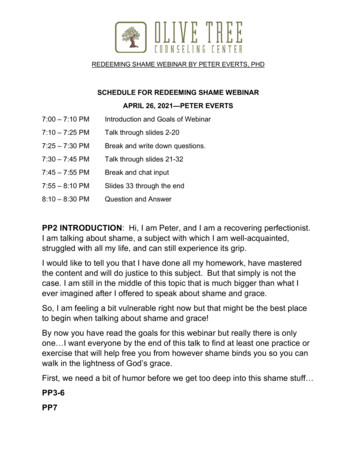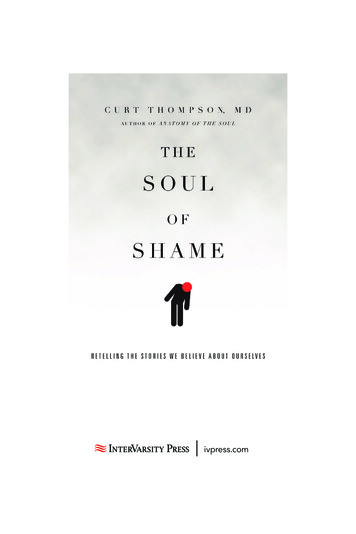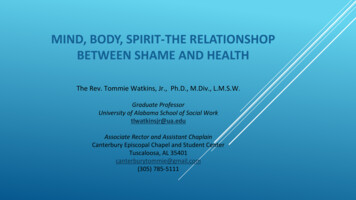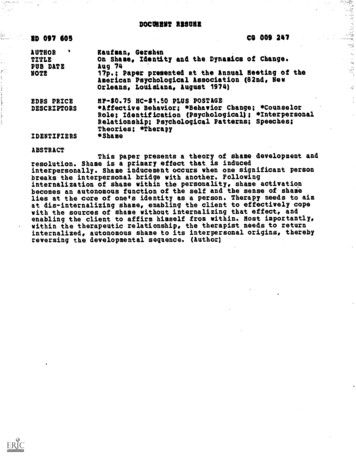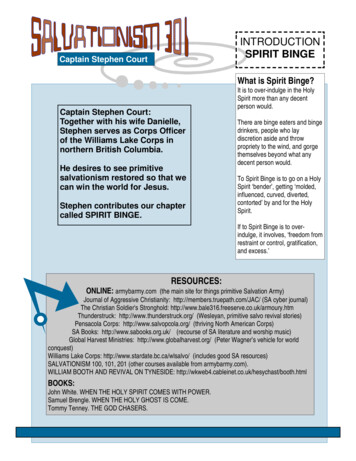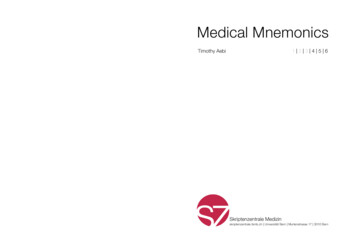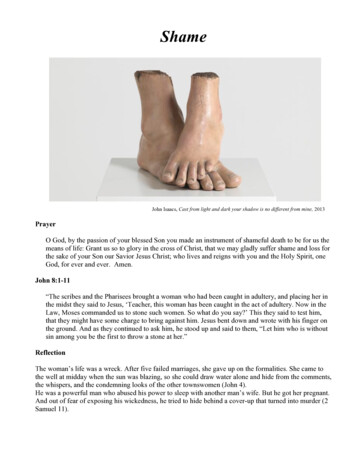
Transcription
ShameJohn Isaacs, Cast from light and dark your shadow is no different from mine, 2013PrayerO God, by the passion of your blessed Son you made an instrument of shameful death to be for us themeans of life: Grant us so to glory in the cross of Christ, that we may gladly suffer shame and loss forthe sake of your Son our Savior Jesus Christ; who lives and reigns with you and the Holy Spirit, oneGod, for ever and ever. Amen.John 8:1-11“The scribes and the Pharisees brought a woman who had been caught in adultery, and placing her inthe midst they said to Jesus, ‘Teacher, this woman has been caught in the act of adultery. Now in theLaw, Moses commanded us to stone such women. So what do you say?’ This they said to test him,that they might have some charge to bring against him. Jesus bent down and wrote with his finger onthe ground. And as they continued to ask him, he stood up and said to them, “Let him who is withoutsin among you be the first to throw a stone at her.”ReflectionThe woman’s life was a wreck. After five failed marriages, she gave up on the formalities. She came tothe well at midday when the sun was blazing, so she could draw water alone and hide from the comments,the whispers, and the condemning looks of the other townswomen (John 4).He was a powerful man who abused his power to sleep with another man’s wife. But he got her pregnant.And out of fear of exposing his wickedness, he tried to hide behind a cover-up that turned into murder (2Samuel 11).
The woman had an affair, betraying her husband and dishonoring her family. She thought she could getaway with it. But then her sin was exposed. Pulled from her bed chamber with little more that a sheet tocover her, she was dragged through the streets by religious authorities to be tried by mob justice andstoned. (Luke 8).Three figures, three stories, share a common experience—shame, the feeling that we are flawed andtherefore unworthy of love and belonging. These figures are not alone. Indeed, shame has plagued ussince Adam and Eve first bit into the forbidden fruit and discovered that they were “naked and ashamed.”We, their descendents, have been living with shame and vulnerability ever since. It is a universal humanexperience.For me, shame is a three-letter word—fat. Throughout my teens, I was overweight, a full 240 lbs when Iwent to college. It was embarrassing, isolating. I wanted to be close to others, yet feared they would notaccept me. Despite being a “big kid,” I often felt small inside. I wore oversized clothes to hide myself,and loathed going to pool or beach. I lost the weight in college, but I acknowledge I still carry the marks,physical and psychological, of that shame.Shame about our bodies is fairly common—even more so on account of today’s social media and selfieobsessed culture—but shame emerges from many sources. It can come from the experience ofdiscrimination or abuse. It can come from disability, poverty, or family instability. It can come fromviolating “norms” of society or the stringent perfectionism of one’s own family. It can come fromflunking out of school, losing a job, or being divorced, or from failing to live up to the picture of theperfect mother or provider for one’s family. It can come from simply being “different” from others orholding unpopular beliefs.Whatever the source, though, the sense that we haveradically disappointed others, that we have failed tolive up to standards of acceptability, can bedebilitating. When we feel shame, we stand exposed,bound and immobilized. Shame reduces us tomuteness, it alienates us from others, and makes usacutely aware of ourselves as deficient. When we areashamed, we bow our heads, not to pray but to hide.Letting someone look us in the eye is especiallypainful because their gaze seems to pierce our soul—the deepest and real self we now fear to be rotten andworthless. The feeling is not just that we have donebad, but that we are bad. In this way, shame erodesour very image of ourselves, our sense that we areworthy of love, that we deserve even to exist.Martha Graham and dancers in Heretic, 1928.Photo by Soichi Sunami.The Cycle of ShameLittle wonder that most of us do all in our power to deny our vulnerability, to hide our shame. The irony,though, is that hiding our shame only increases it. The higher the lies are stacked, the more likely they areto topple, as the games we play get more and more complicated. And, because we cannot admit and dealwith our shame, we use shame to try to stay one step ahead., protecting ourselves by shaming and lookingdown on others.
Unsurprisingly, the Bible throws light on the darkness of our condition. Take for example the story,mentioned above, of the adulteress dragged before Jesus, from John 8. Here the scribes and Pharisees useshame as a weapon., hoping to trick Jesus into saying or doing something that will discredit or dishonorhimself. Their plan depends, for its effectiveness, on the elevation of themselves at the expense ofJesus—and the woman. Indeed, she is doubly degraded—not only is she publicly exposed as anadulteress, but she is only being used to get at Jesus.Confident in their self-righteousness, thePharisees and scribes barge into Jesus’ presence.They come as a group, as representatives of therevered Law and Temple. But Jesus will havenothing of it. With a word, he shatters thesolidarity of the shamers: “Let him who is withoutsin among you be the first to throw a stone ather.” (v7)Here Jesus turns their shaming around on thereligious authorities, shaming the shamers: Tomeet Jesus’ challenge requires singling yourselfout as “the first” and so exposing yourself forjudgment. To step forward into the middle of thestoning circle makes you liable to shame, since noone can honorably claim to be free of sin.Its solidarity broken, the mob dissolves, one byone, beginning with the oldest. This, we assume,is because the oldest among them have had thelongest time to accumulate a collection of sins,and thus the greatest guilt.It is an impressive reversal. The Pharisees hadsought to use shame to hurt and destroy. Jesusused that shame instead to rescue a degradedwoman. He does not deny her sin, but he refusesto let shame have the last word or define her:“Neither do I condemn you; go, and do not sinagain” (v11).In this painting, “The Shadow In the Middle,” by contemporaryartist Daniel Bonnell, Jesus and the adulterous woman are literallyup against the wall. The wall is pocked with holes, as if shot up by afiring squad. The executioners are unseen, represented only by theirlooming shadows and the rocks before them. Yet, Jesus standsabove her, his hand resting upon her head in protection and comfort.The story presents a vivid demonstration of Jesus’wisdom and mercy. But it is more than that. In hisresponse to the mob, Jesus points a way out ofthe vicious circle of shame that we get caught upin. Following that way means refusing to hurt others with their shame, and, more dauntingly, admittingour own shame. But how can we risk doing that? We are really afraid we are worthless, that others wouldabandon us if they knew us as we are. So how can we admit shame without annihilating ourselves?Shame CrucifiedThe beginning of an answer lies in Jesus, in the Cross. We tend to see crucifixion as a awful death mainlybecause of its terrible physical pain. Movies like The Passion and revivalist preachers often describe in
excruciating detail the pain of the whip and nails and the slow suffocation. But what the early Christiansmost dreaded about the cross was in fact its shame.You see, crucifixion was a form of execution reserved for those least worthy of respect: slaves, criminals,and rebels against the state. It was deliberately public, which intensified its disgrace. Not infrequently, thecondemned was already dead before they were crucified, the shaming of their name and reputation afurther punishment after they could no longer feel physical pain.The author of Hebrews hits the nail on the head when he states that Jesus endured the cross by“disregarding its shame” (12:2). Shame is also clearly a central concern of the gospel writers in theiraccounts of the Passion. Just as shame binds us, silences us, makes us self-conscious and afraid ofrejection, Jesus, the gospels tell us, is literally bound, falls mute before Pilate, and is rejected by thecrowd and mocked by soldiers and even those executed with him. Just as shame exposes our vulnerabilityand makes us powerless, Jesus dies naked and impotent, having “saved others” but evidently unable to“save himself”. And, just as shame involves fear of abandonment, Jesus dies in seeming despair, “MyGod, my God, why hast thou forsaken me?”Once again, Jesus’ enemies use shame in an attempt to destroy him. And this time they succeed. Jesus hasbeen profoundly shamed, discredited, his mission exposed as a sham, his followers scattered. In contrastto the adulteress, shame for Jesus does seem to have the last word and does finally define him. He dies,scorned and cursed.That is not the end of the story, of course. God’s resurrection of Jesus vindicates him and his mission andrestores his honor. The resurrection is deep reassurance—exactly the reassurance we need—that shamedoes not destroy. The resurrection gives us hope in the face of shame.It is not that because of the resurrection we are somehow immune to shame. We are not “unashamed”—that way leads too easily to being “shameless,” a term used in Scripture always as a judgment. Our hopeis not that resurrection obliterates the shame of crucifixion. Our hope is that resurrection transforms andparadoxically elevates the shame of crucifixion.The Gospels see Jesus’ shame and weakness as the pre-eminent revelation of God’s power—Johnconsiders it nothing less than his “glorification” (John 3:14; 12:28–33). Paul insists that Jesus acceptedshame—became a curse—so that we might be blessed (Gal 3:13–14). And as we await our ownresurrection, we are called to bear the Cross and its shame. If we are not ashamed of Jesus beforehumanity, he will not be ashamed of us before the Father (Mark 8:38).So, our hope is not that our shame has ended. Our hope is that Jesus bore shame to the cross and shamedit. Shame was crucified, disarmed and publicly stripped of its destructiveness (Col. 2:15). By enduring thecross, Jesus suffered shame’s worst effects and yet was vindicated by God. In that pivotal event, ourworth was secured. No shame, however just or unjust, however petty or monumental, can “separate usfrom the love of God in Christ Jesus our Lord” (Rom. 8:39). As disciples of the Crucified One, we arepart a community of people who are no longer afraid of being defined and destroyed by shame and whocan therefore admit their failures and their need for others, for connection and acceptance. No longer dowe need to deny our shame and foist it off on others. For on the cross, our shame has been embraced andovercome.
Meditation QuestionsWhat do these contemporary art pieces suggest to you about shame?Where does your shame reside? Where do you feel most vulnerable and deficient?Julia Stankova, The Woman Caught In Adultery, 2015Where is Jesus in your shame?
How has shame crippled you, silenced you, isolated you from others?Andrey Mironov, Christ and the Sinner, 2011What do you suppose Jesus was writing in the sand?Yongsung Kim, Forgiven, 2008
Allen Tan, Jesus and the Woman Caught In Adultery, 2015Observe the hidden image: turn the image upside down
“disregarding its shame” (12:2). Shame is also clearly a central concern of the gospel writers in their accounts of the Passion. Just as shame binds us, silences us, makes us self-conscious and afraid of rejection, Jesus, the gospels tell us
